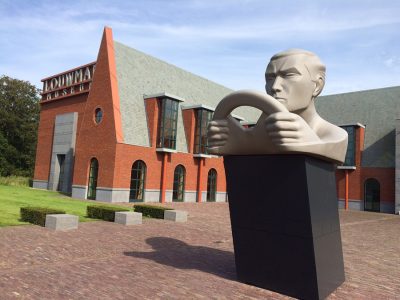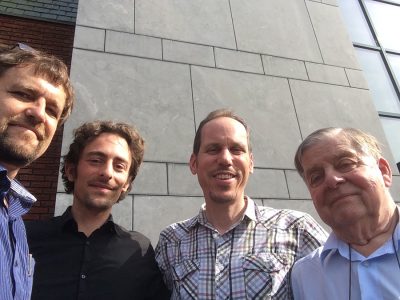Marvin Bolt, the Museum’s curator of science and technology, traveled to Europe last fall to research some of the world’s oldest telescopes. Read along to hear about his adventures and discoveries.
- The Louwman Museum in Wassenaar
- Telescope hunters Marvin Bolt, Tiemen Cocquyt, Michael Korey, and Peter Louwman
Our first extensive telescopic investigations took place at the Louwman Museum in Wassenaar, a suburb of The Hague. The Louwman Museum opened five years ago as one of the world’s pre-eminent car museums, founded by a family of car dealers whose business goes back nearly a century. In an upstairs gallery is the Louwman collection of historic telescopes, the largest collection of historic telescopes in the world. It includes several 17th-century examples, a few of which we will examine in detail. We had originally planned to stay only one day, but ended up staying three. And then yet another when we ran out of time.
The highlight of the first day came from a telescope that had given previous researchers few clues to identify it. Some obscure writing on the tube could be seen, but not read. On seeing it, though, I realized that it looked very similar to one I had found a decade ago in a storeroom in Kassel, Germany.
Further study showed other similarities. But the most surprising find was a strip of paper on the innermost tube, recycled because paper was so precious in the 17th century.
Out came one of my new toys/tools, a borescope. Some careful handling, and we had a video of the text. I had a hard time waiting to decipher it, but I managed to wait until the museum closed. The few words on this strip indicated it was a Latin theological text: “Nam vera fides & poenitentia semper pacem obtinent.” It wasn’t a big surprise, then, to find that the text came from a 1634 book, Determinationes quaestionum quarundam theologicarum, by Jean Davenant (Davenantius) or John Davenant.
John Davenant (1572 – 1641) was an English scholar who also served as the bishop of Salisbury after 1621. His religious views likely play an important role in our story, as he served as a British delegate to the Synod of Dort (1618) in the Netherlands. That six-month-long church council addressed the theological conflicts between Arminians and Calvinists. Davenant argued for the positions of the Calvinists, whose so-called five points were put forth in the Canons of Dort, reflecting the “winning” Calvinist position. Davenant found himself in the middle of further disagreements within the Calvinist camp, and articulated a middle ground position that found favor and offered to provide a satisfactory compromise that enabled some union rather than further division.
More work remains to be done researching Davenant’s writings and their impact in the Netherlands but it isn’t difficult to imagine that his ability to compromise would find some traction in the Netherlands and that his books would be read there, for example, in the university town of Leiden, home of Franciscus Gomarus, leader of the Calvinist camp at the Synod of Dort.
The telescope gives a fine view, with some coloration that you would expect from an early telescope. The museum gives priority parking to cars over 25 years old; you can see the trunk of this early Citroen magnified a few times when seen through this instrument.
The text suggests that the telescope is no earlier than 1634, but it is exciting to think it could be fairly soon after that. Printers re-used paper from misprints, for example, and early telescope tubes were often made from recycled paper and covered with leather by bookbinders.

The Ronchi test shows how the central portion of this lens
is of decent optical quality, but the curvature of the line to
the right shows significant deviation in the lens’s shape
from an optimal one.
We also carried out an optical test, a Ronchi test, of the current lens. This Ronchi test shows how the central portion of this lens is of decent optical quality, but the curvature of the line to the right shows significant deviation in the lens’s shape from an optimal one. This variation in quality (from the center of the lens towards the edge) is typical of most early telescope lenses, and is not usually found in later ones.
The results almost certainly indicate that the object is from the first half of the 17th century, making it one of the earliest telescopes that still survive. Further comparison with the telescope in Kassel, a later stop on our tour, might suggest further information about when and where this interesting telescope came from.





